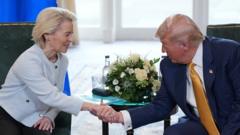The United States and the European Union have struck a pivotal trade deal, signaling an end to a lengthy standoff between two major economic powers. The agreement was finalized after crucial negotiations between President Donald Trump and European Commission President Ursula Von der Leyen during a meeting in Scotland. Under the new terms, a blanket tariff of 15% on all EU goods entering the US has been established, halving the original threat of a 30% import tax that Trump had intended to impose.
Trump emphasized that this new tariff rate will foster increased American investment, as the 27-member bloc agrees to open its markets without tariffs on select American exports. He portrayed the deal as beneficial for both sides, stating, "It's going to bring us closer together." Von der Leyen echoed this sentiment, noting the deal's potential to stabilize relations and enhance economic cooperation.
The agreement follows Trump's strategy to negotiate similar tariffs with other countries such as the UK, Japan, and Vietnam, despite falling short of his ambitious goal of securing "90 deals in 90 days." The deal was announced following private discussions at Trump’s Turnberry golf course, where he expressed confidence in the agreement. “We have reached a deal. It’s a good deal for everybody,” he stated.
According to Trump, the EU is expected to invest upwards of $600 billion in the US economy and spend heavily on military equipment and energy, including liquefied natural gas, oil, and nuclear fuels, aiming to reduce European dependency on Russian energy. Von der Leyen praised Trump for his decisive leadership in reaching this agreement, despite the challenges that arose during negotiations.
For the EU, this tariff outcome avoids potentially harsher penalties; while it isn’t as favorable as the UK’s 10% tariff rate, it stands equal to Japan's 15% deal. Conversely, the US anticipates approximately $90 billion in tariff revenue with this new arrangement, based on last year’s trade data.
Trade between the EU and the US was valued at nearly $975.9 billion last year, creating a significant trade deficit for the US, which imports more from the EU than it exports. If Trump's original tariff plans had been implemented, various goods from the EU including pharmaceuticals, electronics, and luxury items would have faced increased costs, prompting potential retaliatory tariffs from the EU on American products.
In the wake of this trade deal, British Prime Minister Keir Starmer is set to meet with Trump next, as the US president continues his visit in Scotland, where he plans to inaugurate another golf course.


















